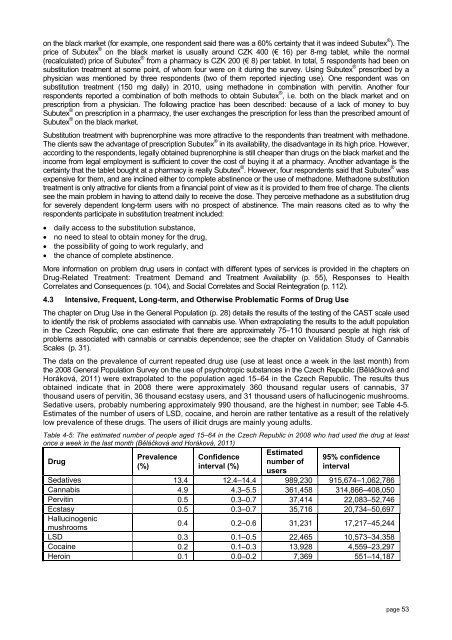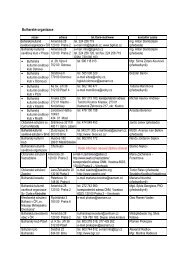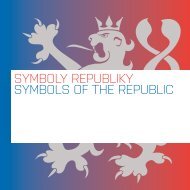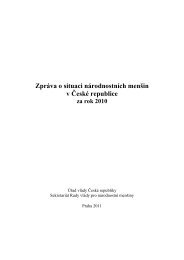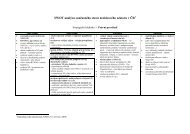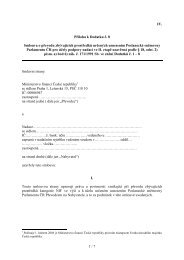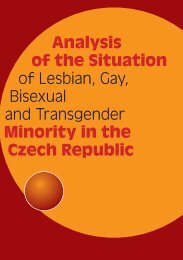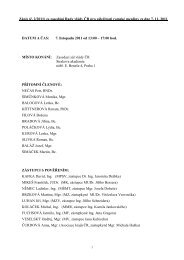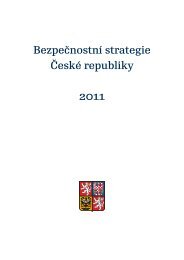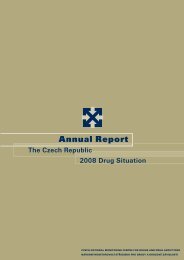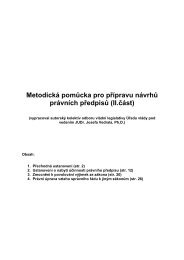The Czech Republic Annual Report 2010 Drug ... - Drogy-info.cz
The Czech Republic Annual Report 2010 Drug ... - Drogy-info.cz
The Czech Republic Annual Report 2010 Drug ... - Drogy-info.cz
You also want an ePaper? Increase the reach of your titles
YUMPU automatically turns print PDFs into web optimized ePapers that Google loves.
on the black market (for example, one respondent said there was a 60% certainty that it was indeed Subutex ® ). <strong>The</strong><br />
price of Subutex ® on the black market is usually around CZK 400 (€ 16) per 8-mg tablet, while the normal<br />
(recalculated) price of Subutex ® from a pharmacy is CZK 200 (€ 8) per tablet. In total, 5 respondents had been on<br />
substitution treatment at some point, of whom four were on it during the survey. Using Subutex ® prescribed by a<br />
physician was mentioned by three respondents (two of them reported injecting use). One respondent was on<br />
substitution treatment (150 mg daily) in <strong>2010</strong>, using methadone in combination with pervitin. Another four<br />
respondents reported a combination of both methods to obtain Subutex ® , i.e. both on the black market and on<br />
prescription from a physician. <strong>The</strong> following practice has been described: because of a lack of money to buy<br />
Subutex ® on prescription in a pharmacy, the user exchanges the prescription for less than the prescribed amount of<br />
Subutex ® on the black market.<br />
Substitution treatment with buprenorphine was more attractive to the respondents than treatment with methadone.<br />
<strong>The</strong> clients saw the advantage of prescription Subutex ® in its availability, the disadvantage in its high price. However,<br />
according to the respondents, legally obtained buprenorphine is still cheaper than drugs on the black market and the<br />
income from legal employment is sufficient to cover the cost of buying it at a pharmacy. Another advantage is the<br />
certainty that the tablet bought at a pharmacy is really Subutex ® . However, four respondents said that Subutex ® was<br />
expensive for them, and are inclined either to complete abstinence or the use of methadone. Methadone substitution<br />
treatment is only attractive for clients from a financial point of view as it is provided to them free of charge. <strong>The</strong> clients<br />
see the main problem in having to attend daily to receive the dose. <strong>The</strong>y perceive methadone as a substitution drug<br />
for severely dependent long-term users with no prospect of abstinence. <strong>The</strong> main reasons cited as to why the<br />
respondents participate in substitution treatment included:<br />
daily access to the substitution substance,<br />
no need to steal to obtain money for the drug,<br />
the possibility of going to work regularly, and<br />
the chance of complete abstinence.<br />
More <strong>info</strong>rmation on problem drug users in contact with different types of services is provided in the chapters on<br />
<strong>Drug</strong>-Related Treatment: Treatment Demand and Treatment Availability (p. 55), Responses to Health<br />
Correlates and Consequences (p. 104), and Social Correlates and Social Reintegration (p. 112).<br />
4.3 Intensive, Frequent, Long-term, and Otherwise Problematic Forms of <strong>Drug</strong> Use<br />
<strong>The</strong> chapter on <strong>Drug</strong> Use in the General Population (p. 28) details the results of the testing of the CAST scale used<br />
to identify the risk of problems associated with cannabis use. When extrapolating the results to the adult population<br />
in the <strong>Czech</strong> <strong>Republic</strong>, one can estimate that there are approximately 75–110 thousand people at high risk of<br />
problems associated with cannabis or cannabis dependence; see the chapter on Validation Study of Cannabis<br />
Scales (p. 31).<br />
<strong>The</strong> data on the prevalence of current repeated drug use (use at least once a week in the last month) from<br />
the 2008 General Population Survey on the use of psychotropic substances in the <strong>Czech</strong> <strong>Republic</strong> (Běláčková and<br />
Horáková, 2011) were extrapolated to the population aged 15–64 in the <strong>Czech</strong> <strong>Republic</strong>. <strong>The</strong> results thus<br />
obtained indicate that in 2008 there were approximately 360 thousand regular users of cannabis, 37<br />
thousand users of pervitin, 36 thousand ecstasy users, and 31 thousand users of hallucinogenic mushrooms.<br />
Sedative users, probably numbering approximately 990 thousand, are the highest in number; see Table 4-5.<br />
Estimates of the number of users of LSD, cocaine, and heroin are rather tentative as a result of the relatively<br />
low prevalence of these drugs. <strong>The</strong> users of illicit drugs are mainly young adults.<br />
Table 4-5: <strong>The</strong> estimated number of people aged 15–64 in the <strong>Czech</strong> <strong>Republic</strong> in 2008 who had used the drug at least<br />
once a week in the last month (Běláčková and Horáková, 2011)<br />
<strong>Drug</strong><br />
Prevalence<br />
(%)<br />
Confidence<br />
interval (%)<br />
Estimated<br />
number of<br />
users<br />
95% confidence<br />
interval<br />
Sedatives 13.4 12.4–14.4 989,230 915,674–1,062,786<br />
Cannabis 4.9 4.3–5.5 361,458 314,866–408,050<br />
Pervitin 0.5 0.3–0.7 37,414 22,083–52,746<br />
Ecstasy 0.5 0.3–0.7 35,716 20,734–50,697<br />
Hallucinogenic<br />
mushrooms<br />
0.4 0.2–0.6 31,231 17,217–45,244<br />
LSD 0.3 0.1–0.5 22,465 10,573–34,358<br />
Cocaine 0.2 0.1–0.3 13,928 4,559–23,297<br />
Heroin 0.1 0.0–0.2 7,369 551–14,187<br />
page 53


